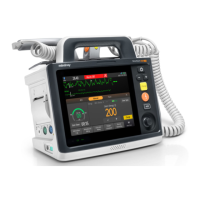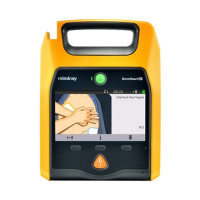5 - 1
5 AED
5.1 AED Safety Information
• Defibrillation current can cause operator or bystander severe injury or even death. Do not touch the
patient or any metal objects (including bed or gurney) connected to the patient during
defibrillation.
• Avoid contact between parts of the patient’s body such as exposed skin of head or limbs, conductive
fluids such as gel, blood, or saline, and metal objects such as a bed frame or a stretcher which may
provide unwanted pathways for the defibrillating current.
• During defibrillation, do not allow electrode pads to contact each other or to contact with ECG
electrodes, lead wires, dressings, etc. Contact with metal objects may divert current away from the
heart, which result in electrical arcing and patient skin burns.
• Motion artifact may delay analysis or affect the ECG signal resulting in an inappropriate shock or no
shock advised message. Do not touch the patient during ECG rhythm analysis or charging in the AED
mode.
• Air pockets between the patient skin and electrode pads can cause electrical arcing and patient skin
burns during defibrillation. To avoid poor adherence and air pockets, make sure electrode pads are
completely adhered to the patient skin.
• Do not use dried-out electrode pads.
• Improper handling of electrode pads during storage or before use can damage the electrode pads.
Discard the electrode pads if they become damaged.
• For patients with implantable pacemaker, the sensitivity and specificity of AED algorithm may be
impaired.
• Successful resuscitation is dependent on many variables specific to the patient’s physiological state
and the circumstances surrounding the patient event. Failure to have a successful patient outcome is
not a reliable indicator of equipment performance. The presence or absence of a muscular response
to the transfer of energy during electrical therapy is not a reliable indicator of energy delivery or
equipment performance.

